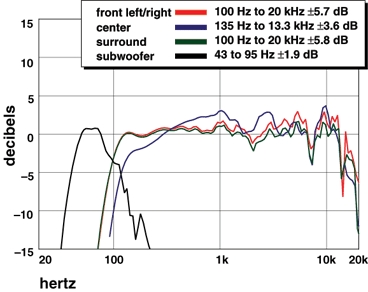Tannoy Arena Home Theater Speaker System Page 3
Test Bench: Tannoy Arena
By Tom Nousaine

Sensitivity (SPL at 1 meter with 2.8 volts of pink-noise input) front left/right/surround: 86 dB center: 87 dB Impedance (minimum/nominal) front left/right/surround: 7.3/8 ohms center: 8.5/14 ohms Bass limits (lowest frequency and maximum SPL with limit of 10% distortion at 2 meters in a large room) front left/right/surround: 80 Hz at 77 dB center: 80 Hz at 71 dB subwoofer: 25 Hz at 82 dB SPL 96 dB average SPL from 25 to 62 Hz 102 dB maximum SPL at 62 Hz bandwidth uniformity 94%
All of the curves in the frequency-response graph are weighted to reflect how sound arrives at a listener's ears with normal speaker placement. The curve for the left/right front channels reflects response of the Arena L/R satellite averaged over a ±30° window, with double weight at 30° (the most typical listening angle). The center-channel curve reflects response of the horizontally oriented Arena center speaker averaged over ±45°, with double weight directly on-axis of the primary listener. The surround-channel curve shows the response of the Arena L/R satellite averaged over ±60°.
Some high-frequency irregularity and marginal low-frequency dynamics cap overall performance of this system. The L/R satellite had uniform directivity with increasingly pronounced roughness above 6 kHz. However, the latter was most significant above 12 kHz and response fit inside a ±3-dB window below 13 kHz. The center speaker had a notch at 2 kHz that was apparent in every trace and became deeper at wider angles. Because the speaker has an asymmetrical driver array, lobing will be worse for listeners seated to the left side.
The Arena subwoofer's bass limits were measured with it set to maximum bandwidth and placed in the optimal corner of a 7,500-cubic-foot room. In a smaller room users can expect 2 to 3 Hz deeper extension and up to 3 dB higher sound-pressure level (SPL). The subwoofer had reasonably uniform but limited dynamic capability. Although the crossover control is labeled 50 Hz to 150 Hz, the acoustical turnover frequencies range between only 73 and 95 Hz. There is no crossover/level interaction in the top half of the crossover control range, but level dropped by 8 dB when the crossover was set to a marked 50 Hz.
- Log in or register to post comments




















































